Deterministic Design Procedures on Limited Field-of-View Planar Arrays for Satellite Communications Employing Aperture Scaling †
Abstract
1. Introduction
2. Materials and Methods
2.1. Scaling Transformation
- Scaling factor equation (Equation (9));
- HPBW equation (Equation (10));
- Directivity equation (Equation (18));
- Sidelobe level (SLL).
2.2. Design Procedure
3. Results
- Sampling of continuous apertures;
- Use of FFoV array synthesis methods.
3.1. Sampling of Continuous Apertures
- The scaling factor is derived from the range of view.
- The FFoV indices SLLF, HPBWF, and DF are derived from the LFoV ones.
- The aperture distribution for the FFoV is found.
- A sampling procedure is followed to transform the continuous distribution to an array.
- The scaling transformation is enforced on the array to produce the final result.
3.1.1. Example A.1
3.1.2. Example A.2
3.2. Use of FFoV Array Synthesis Methods
- The scaling factor is derived from the range of view;
- The FFoV indices SLLF, HPBWF, and DF are derived from the LFoV ones;
- A FFoV array synthesis method is used to provide the FFoV solution;
- The scaling transformation is enforced on the array to produce the final result.
3.2.1. Example B.1
3.2.2. Example B.2
4. Conclusions
Funding
Institutional Review Board Statement
Informed Consent Statement
Data Availability Statement
Acknowledgments
Conflicts of Interest
Appendix A
References
- Kaifas, T.N.; Samaras, T.; Siakavara, K.; Sahalos, J.N. A UTD-OM technique to design slot arrays on a perfectly conducting paraboloid. IEEE Trans. Antennas Propag. 2005, 53, 1688–1698. [Google Scholar] [CrossRef]
- Kaifas, T.N.; Sahalos, J.N. Design and Performance Aspects of an Adaptive Cylindrical Beamforming Array. IEEE Antennas Propag. Mag. 2012, 54, 51–65. [Google Scholar] [CrossRef]
- Kaifas, T.N.; Siakavara, K.; Vafiadis, E.; Samaras, T.; Sahalos, J.N. On the design of conformal slot arrays on a perfectly conducting elliptic cone. Electr. Eng. 2006, 89, 95–105. [Google Scholar] [CrossRef]
- Milligan, T.A. Space tapered circular (ring) array. IEEE Antennas Propag. Mag. 2004, 46, 70–73. [Google Scholar] [CrossRef]
- Skolnik, M.I.; Sherman, J.W.; Ogg, F.C. Statistically Designed Density-Tapered Arrays. IEEE Trans Antennas Propag. 1964, 12, 408–409. [Google Scholar] [CrossRef]
- Kaifas, T.N.; Babas, D.G.; Toso, G.; Sahalos, J.N. Μultibeam Antennas for Global Satellite Coverage: Theory and Design. IET Microw. Antennas Propag. 2016, 10, 1475. [Google Scholar] [CrossRef]
- Kaifas, T.N. Direct radiating array design via convex aperture synthesis, pareto front theory, and deterministic sampling [antenna designer’s notebook]. IEEE Antennas Propag. Mag. 2014, 56, 134–151. [Google Scholar] [CrossRef]
- Kaifas, T.N.; Babas, D.G.; Miaris, G.S.; Vafiadis, E.E.; Siakavara, K.; Toso, G.; Sahalos, J.N. A Stochastic Study of Large Arrays Related to the Number of Electrically Large Aperture Radiators. IEEE Trans. Antennas Propag. 2014, 62, 3520–3533. [Google Scholar] [CrossRef]
- Kaifas, T.N.; Sahalos, J.N. On the Geometry Synthesis of Arrays with a Given Excitation by the Orthogonal Method. IEEE Trans. Antennas Propag. 2008, 56, 3680–3688. [Google Scholar] [CrossRef]
- Kaifas, T.N.; Babas, D.G.; Sahalos, J.N. Design of Planar Arrays with Reduced Nonuniform Excitation Subject to Constraints on the Resulting Pattern and the Directivity. IEEE Trans. Antennas Propag. 2009, 57, 2270–2278. [Google Scholar] [CrossRef]
- Kaifas, T.N.; Babas, D.G.; Miaris, G.S.; Siakavara, K.; Vafiadis, E.; Sahalos, J.N. Aperiodic Array Layout Optimization by the Constraint Relaxation Approach. IEEE Trans. Antennas Propag. 2012, 60, 148–163. [Google Scholar] [CrossRef]
- Dolph, C.L. A current distribution for broadside arrays which optimizes the relationship between beamwidth and sidelobe level. Proc. IRE 1946, 34, 335–348. [Google Scholar] [CrossRef]
- Villeneuve, T. Taylor patterns for discrete arrays. IEEE Trans. Antennas Propag. 1984, 32, 1089–1092. [Google Scholar] [CrossRef]
- Orchard, H.J.; Elliott, R.S.; Stern, G.J. Optimising the synthesis of shaped beam antenna patterns. IEE Proc. H (Microw. Antennas Propag.) 1985, 132, 63–68. [Google Scholar] [CrossRef]
- Sahalos, J.N. Orthogonal Methods for Array Synthesis: Theory & the ORAMA Computer Tool; Wiley: West Sussex, UK, 2006. [Google Scholar]
- Doundoulakis, G.; Gethin, S. Far field patterns of circular paraboloidal reflectors. In 1958 IRE International Convention Record; IEEE: New York, NY, USA, 1959; pp. 155–173. [Google Scholar] [CrossRef]
- Hansen, R.C. Circular aperture distribution with one parameter. Electron. Lett. 1975, 11, 184. [Google Scholar] [CrossRef]
- Hansen, R.C. A one-parameter circular aperture distribution with narrow beamwidth and low sidelobes. IEEE Trans Antennas Propag. 1976, 24, 477–480. [Google Scholar] [CrossRef]
- Taylor, T.T. Design of circular apertures for narrow beamwidth and low side lobes. IRE Trans Antennas Propag. 1960, 8, 17–22. [Google Scholar] [CrossRef]
- Bayliss, E.T. Design of monopulse antenna difference patterns with low sidelobes. Bell Syst. Tech. J. 1968, 47, 623–650. [Google Scholar] [CrossRef]
- Fante, R.L.; Robertshaw, G.A.; Zamoscianyk, S. Observation and Explanation of an Unusual Feature of Random Arrays with a nearest—Neighbor Constraint. IEEE Trans Antennas Propag. 1991, 39, 1047–1049. [Google Scholar] [CrossRef]
- Lo, Y.T. A mathematical theory of antenna arrays with randomly spaced elements. IEEE Trans. Antennas Propag. 1964, 12, 257–268. [Google Scholar] [CrossRef]
- Milligan, T. Modern Antenna Design, 2nd ed.; Wiley: Hoboken, NJ, USA, 2005. [Google Scholar]
- Chitre, M.A.; Potter, J.R. Optimization and beamforming of a two-dimensional sparse array. In Proceedings of the High Performance Computing ‘98, Singapore, 23–25 September 1998. [Google Scholar]
- Anderson, P.D.; Ingram, M.A.; Tripp, V.K. A New Density Tapering Method Based on Radial Warping. IEEE Trans Antennas Propag. 1998, 46, 1763–1764. [Google Scholar] [CrossRef]
- Tseng, F.I.; Cheng, D.K. Optimum scannable planar arrays with an invariant side-lobe level. Proc. IEEE 1968, 56, 1771–1778. [Google Scholar] [CrossRef]
- Willey, R.E. Space Tapering of Linear and Planar Arrays. IRE Trans Antennas Propag. 1962, 10, 369–377. [Google Scholar] [CrossRef]
- Zhang, S.; Gong, S.X.; Guan, Y.; Zhang, P.F.; Gong, Q. A novel IGA-EDSPSO hybrid algorithm for the synthesis of sparse arrays. Prog. Electromagn. Res. 2009, 89, 121–134. [Google Scholar] [CrossRef]
- Morabito, F.; Isernia, T.; Labate, M.G.; Durso, M.; Bucci, O.M. Direct radiating arrays for satellite communications via aperiodic tilings. Prog. Electromagn. Res. 2009, 93, 107–124. [Google Scholar] [CrossRef]
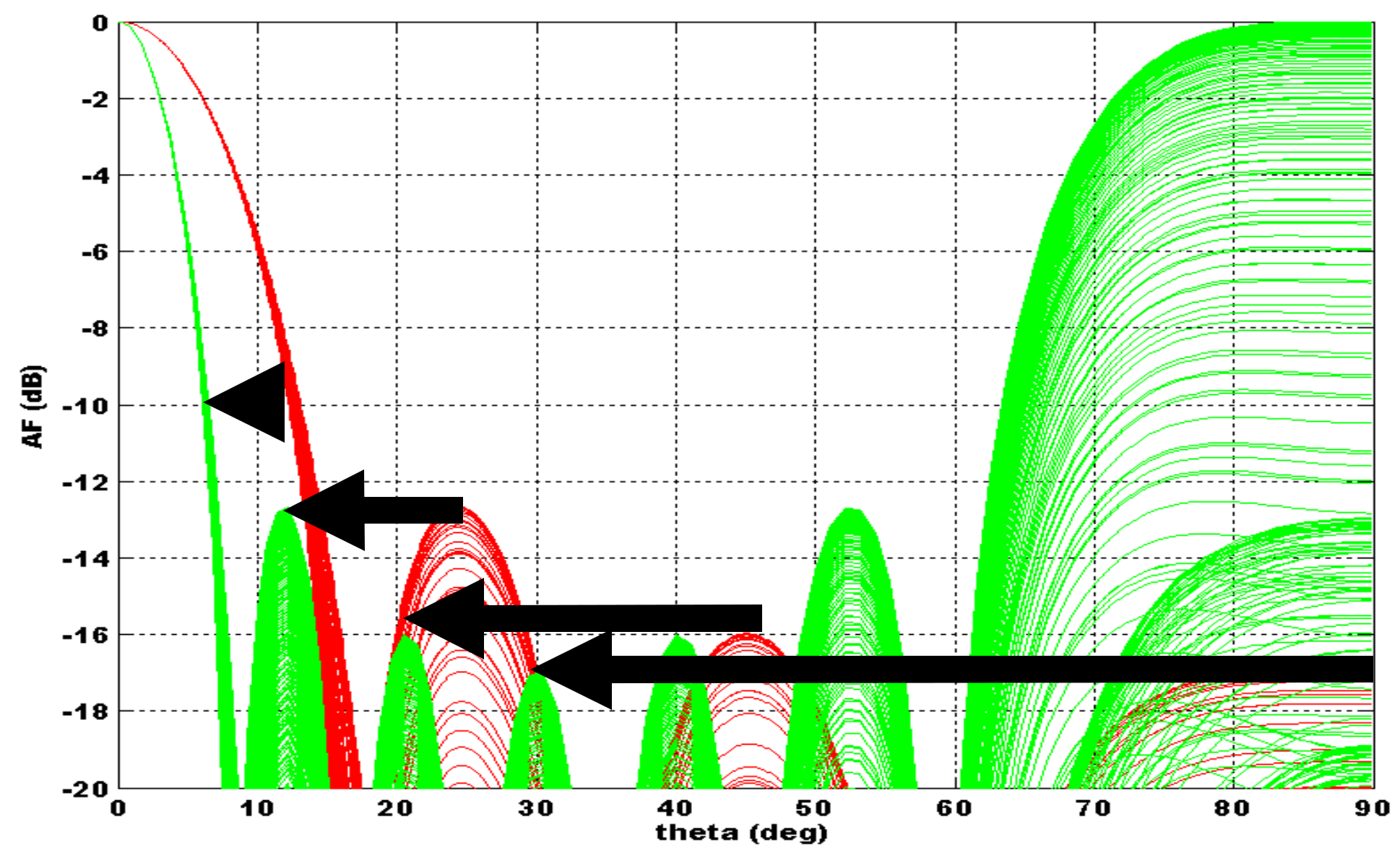

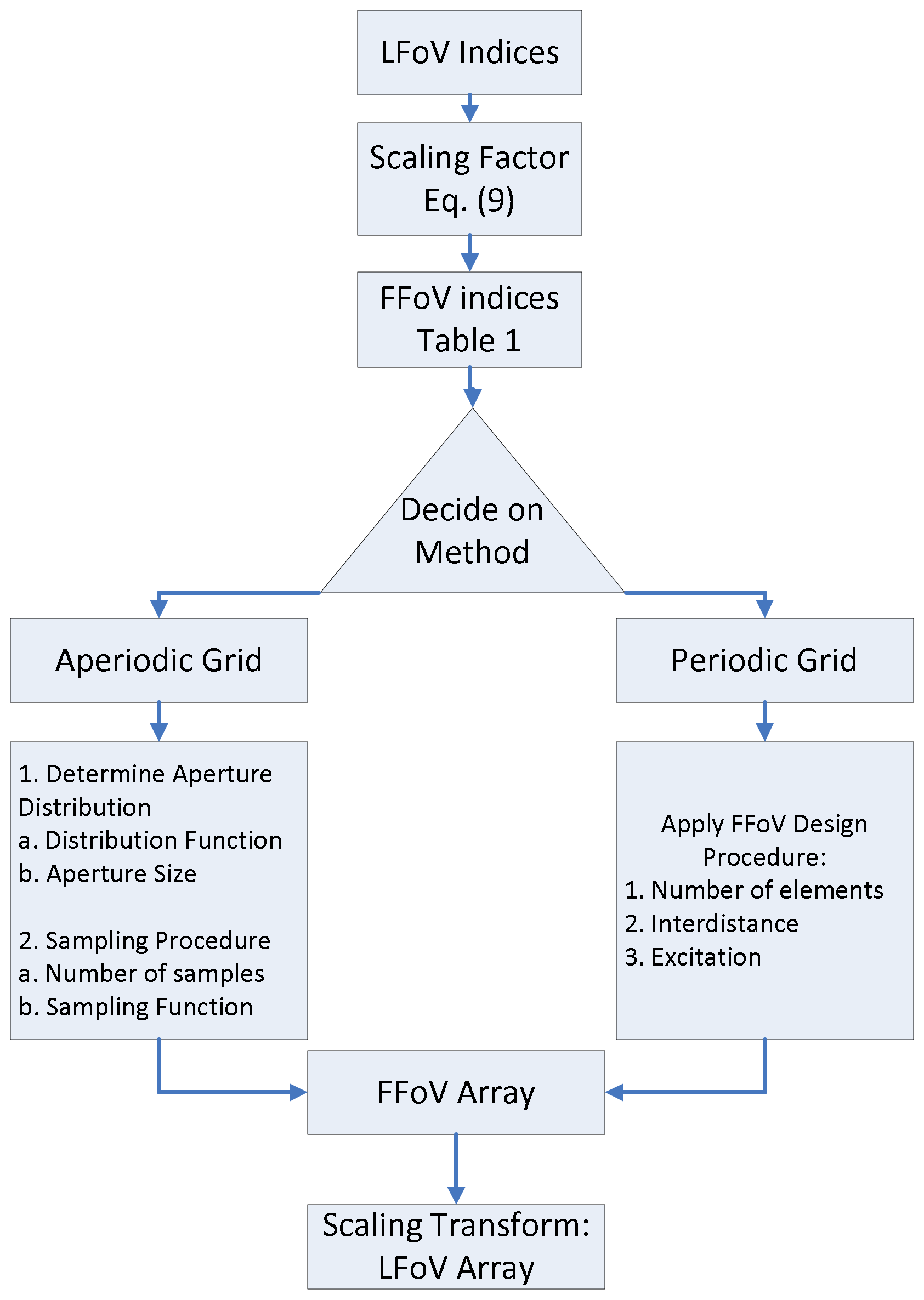
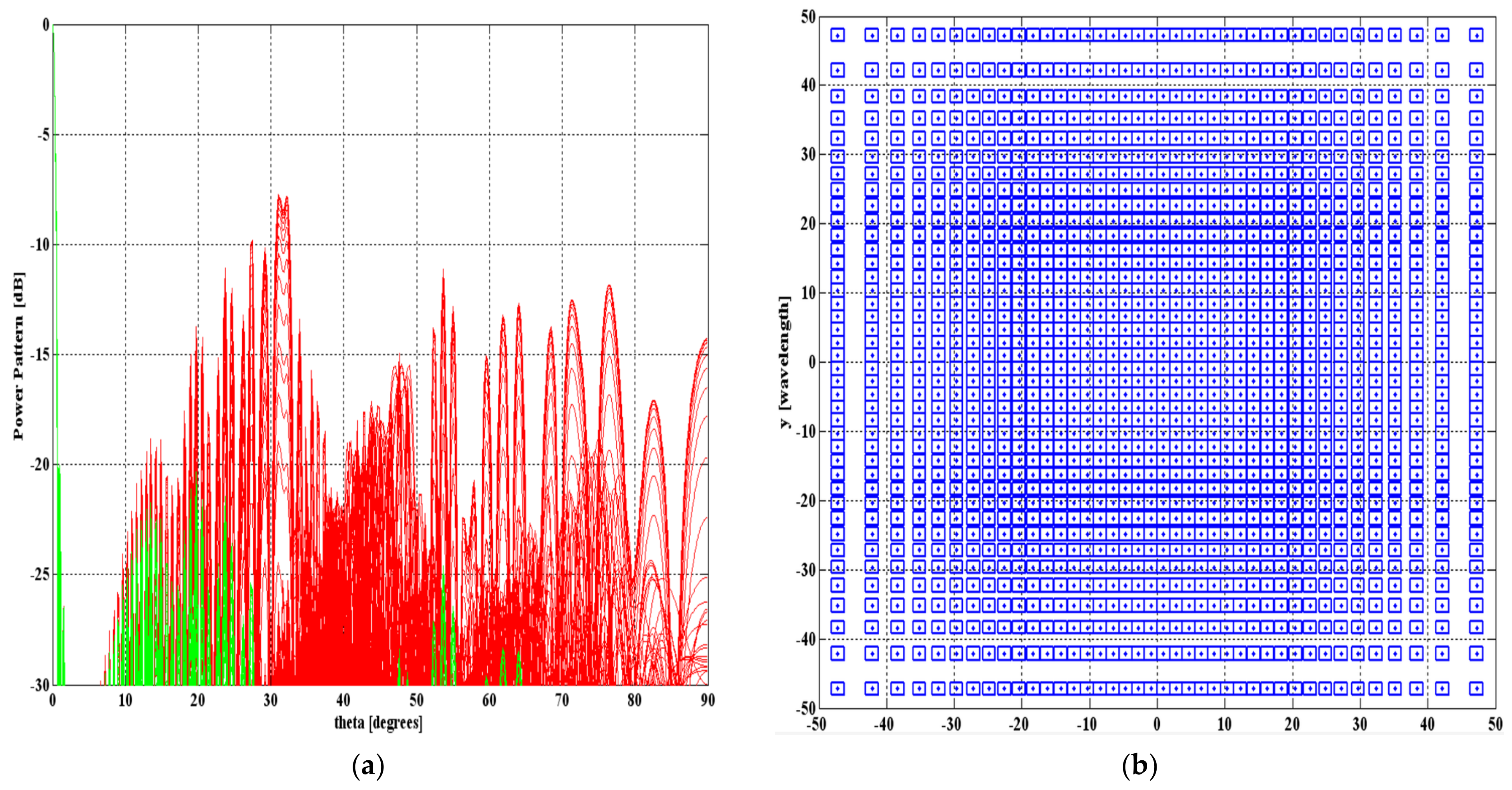

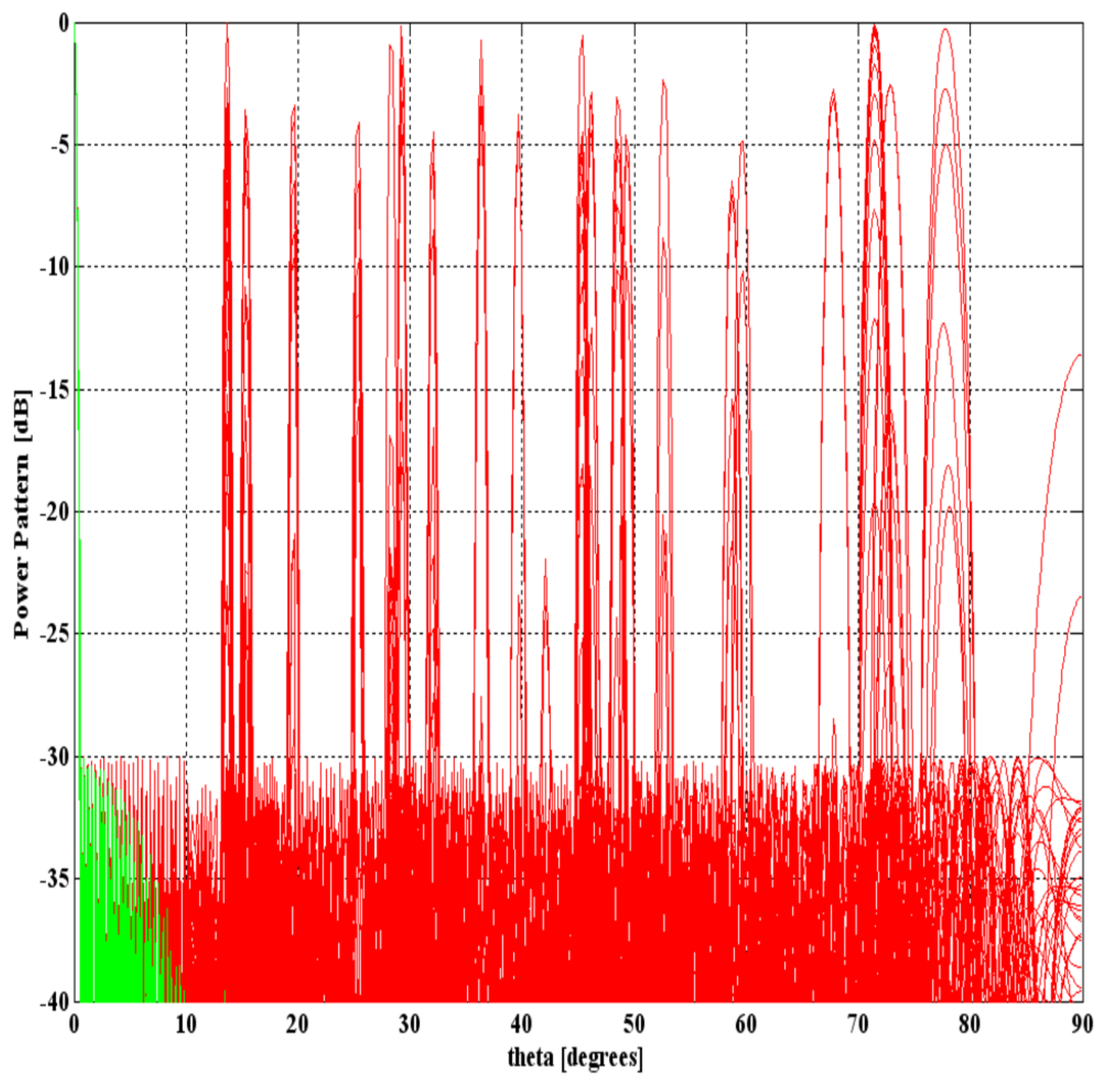
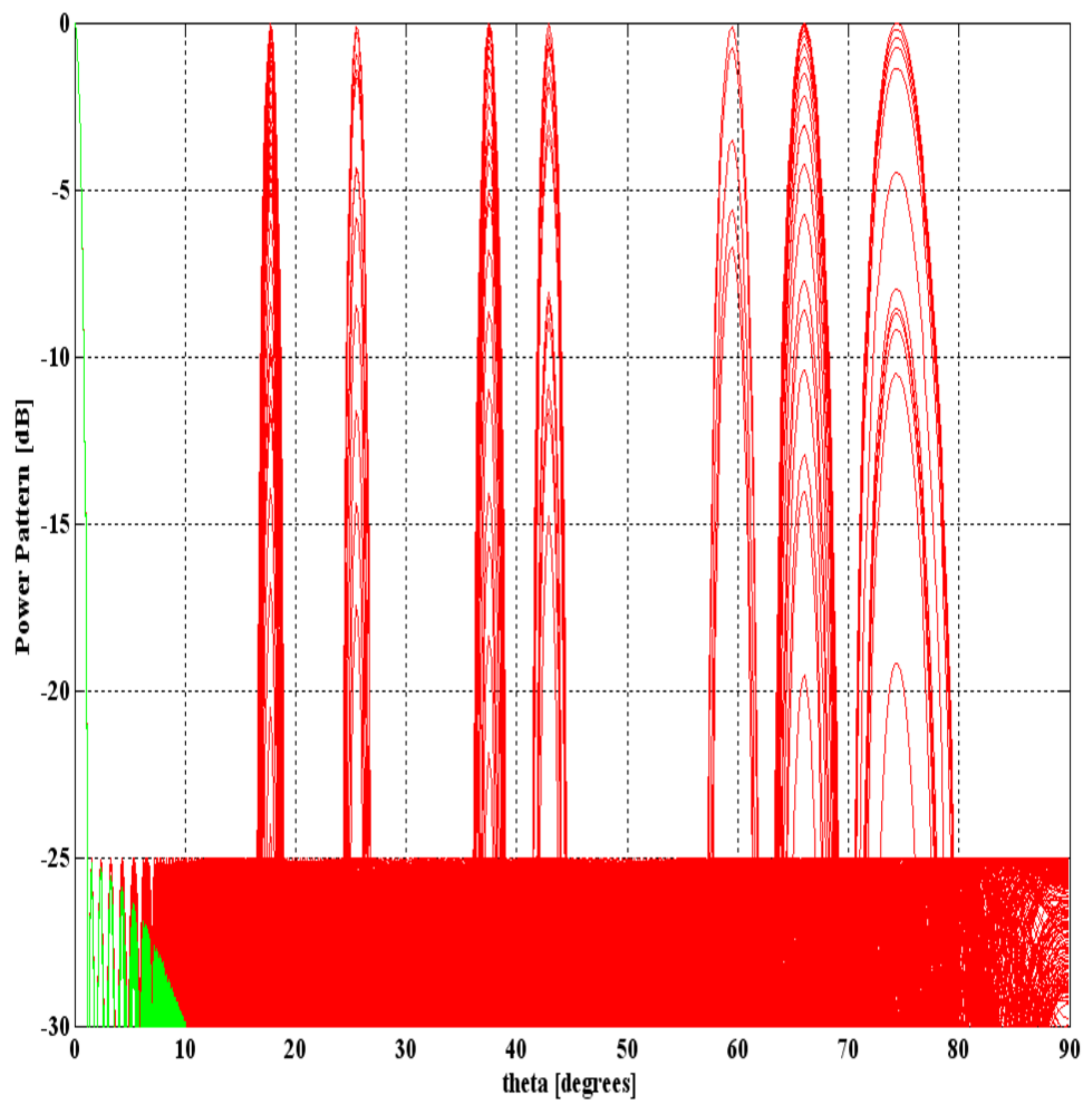
| LFoV Prescription | Scaling Transform Equation | FFoV Prescription |
|---|---|---|
| From 0 to θ0 | From 0 to π/2 | |
| HPBWL | HPBWF | |
| SLLL | SLLF | |
| DL | DF |
Disclaimer/Publisher’s Note: The statements, opinions and data contained in all publications are solely those of the individual author(s) and contributor(s) and not of MDPI and/or the editor(s). MDPI and/or the editor(s) disclaim responsibility for any injury to people or property resulting from any ideas, methods, instructions or products referred to in the content. |
© 2024 by the author. Licensee MDPI, Basel, Switzerland. This article is an open access article distributed under the terms and conditions of the Creative Commons Attribution (CC BY) license (https://creativecommons.org/licenses/by/4.0/).
Share and Cite
Kaifas, T.N.F. Deterministic Design Procedures on Limited Field-of-View Planar Arrays for Satellite Communications Employing Aperture Scaling. Eng. Proc. 2024, 70, 17. https://doi.org/10.3390/engproc2024070017
Kaifas TNF. Deterministic Design Procedures on Limited Field-of-View Planar Arrays for Satellite Communications Employing Aperture Scaling. Engineering Proceedings. 2024; 70(1):17. https://doi.org/10.3390/engproc2024070017
Chicago/Turabian StyleKaifas, Theodoros N. F. 2024. "Deterministic Design Procedures on Limited Field-of-View Planar Arrays for Satellite Communications Employing Aperture Scaling" Engineering Proceedings 70, no. 1: 17. https://doi.org/10.3390/engproc2024070017
APA StyleKaifas, T. N. F. (2024). Deterministic Design Procedures on Limited Field-of-View Planar Arrays for Satellite Communications Employing Aperture Scaling. Engineering Proceedings, 70(1), 17. https://doi.org/10.3390/engproc2024070017





